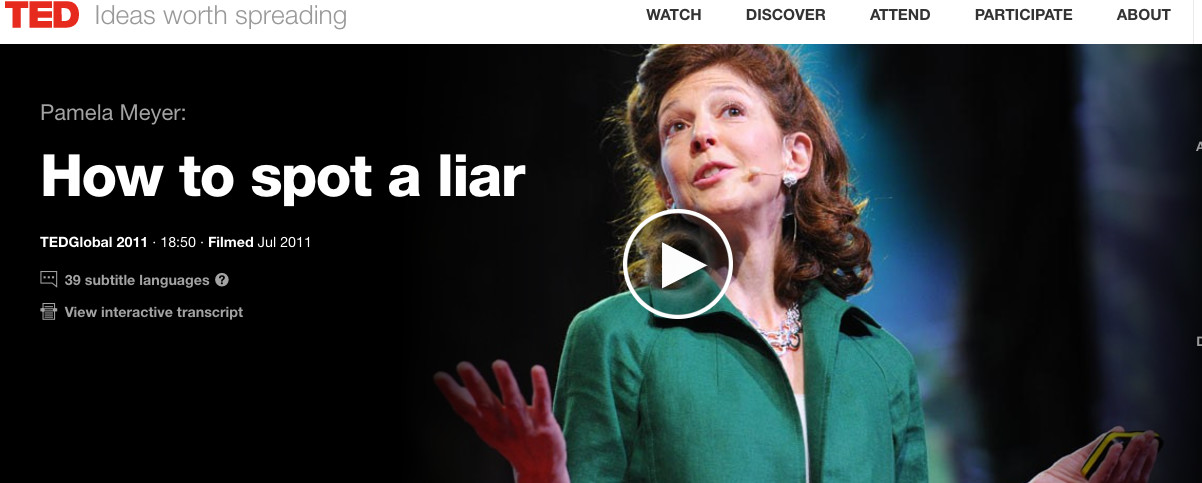
TED pick of the week: Pamela Meyer, How to spot a liar
A colleague of mine, a self-confessed hardcore learner, regularly goes on weekend learning sprees. He chooses a skill to master, establishes the learning outcomes, finds appropriate resources, and spends the whole week-end enjoying the process. When he described his learning expeditions to me, he was so inspiring that I wanted to try it out.
But what should be the subject of my learning experiment?
As I wrote in my previous post, I recently started a new project: listening to a TED talk a day. The talks I choose cover a variety of topics -- artificial intelligence, education, fashion -- but pretty soon a pattern emerged. The topic that occurred most was human interaction, in all its manifestations.
That's how I came upon Pamela Meyer, How to spot a liar. I felt immediately intrigued and decided to spend a week-end learning about detecting little white lies, dirty tricks, and other types of deception.
Meyer is a certified fraud examiner, the author of the book Liespotting: Proven Techniques to Detect Deception, and a CEO of a training company.
Lie detection is not new -- any quick google search would return multiple results -- but to me, Meyer's pragmatic and nuanced approach stands out. To write her book, she conducted extensive research and received training herself. Thus it is safe to assume that she knows her trade.
Her main postulate is the following: we cannot make people stop lying, but we can learn to detect the signs of deception and therefore protect ourselves.
How do we do it? Below are three tips from Meyer and from my personal week-end in the world of lie detection.
First, observe body language.
But do so with caution. Meyer rightly reminds us that we are all human with a wide variety of body language and that there are many misconceptions of how a "typical" liar behaves. In 2015, the BBC published an article entitled The best (and worst) ways to spot a liar, with similar conclusions: there is the huge variety of human behaviour and no universal dictionary of body language.
Yet, there are some gestures and expressions worth noticing. Meyer describes several tell tale signs of lying, such as duping delight and contempt. The first signals deception and manipulation; the second, deception and danger.
To this, I would add my personal favourite. Years ago, when I lived in London, a suitor invited me out. He was an Ivy league educated senior partner in a law firm, and divorced. The venue was a Michelin-star restaurant, the conversation was exciting, and I liked his sense of humour. The evening seemed perfect, until I noticed something bizarre. While mentioning his "ex-girlfriend", he suddenly placed his hands under the table. I could not interpret the gesture but found it sufficiently odd to decline his further invitations. It turned out that his "ex-girlfriend" not only was living with him, but was heavily pregnant.
I witnessed the same gesture recently. A new hire suggested -- perhaps a bit too early and too eagerly -- that we lunch together, as he wanted to learn about my recent deals. At the restaurant, when I asked about the scope of his work, he suddenly placed his hands under the table. "Aha", I thought, "there must be a hidden agenda". Sure enough, within a month he began wooing one of my top clients.
Second, look for discrepancies in behaviour, words, and vocal tonality.
Experts in negotiation recommend establishing rapport -- by doing some small talk -- before getting down to business, as people are more likely to trust someone they can relate to. The lie spotters do the same to a different end: by engaging their interlocutor in friendly chatter about innocent and safe topics, they establish a baseline of behaviour, speech patterns, and gestures -- against which they then compare the behaviour when tackling potentially explosive subjects.
In other words, it is not that much the body language and verbal ticks per se, but any irregularities that you should pay attention to. When a hard nosed salesman starts waxing lyrical how much he cares for his clients, most likely the deal he is about to offer is not as good as he pretends it to be. When someone suddenly without reason calls you 'My dear Madame', or, worse, Ma chère madame, probably he does not have your best interests at heart. When a typically stone faced manager gets visibly irritated at a seemingly innocent question -- pay attention and dig deeper.
Third, familiarise yourself with standard manipulation techniques.
These techniques, such as a "good cop - bad cop" routine, red herring, or "my hands are tied", are often used in negotiations, interviews, and other difficult conversations, in order to destabilise you and to shift the balance of power to your disadvantage.
Do yourself a service: learn to detect these manipulation techniques and to recognise what they are concealing, in order to counter them effectively. Taking a good negotiation course, such as this by Aurélien Colson or this one by George Siedel, would help. Reading a book or a couple of articles could be useful. But even just listening to the TED talk by Pamela Meyer would make you aware of these dirty tricks: forewarned is forearmed!
***
Disclaimer: Opinions expressed in this article are solely my own and do not express the views or opinions of my employer. Unless explicitly mentioned, any resemblance to actual persons, living or dead, or actual events is purely coincidental.